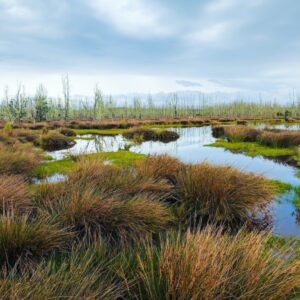Supreme Court Narrows Scope of the Clean Water Act
June 1, 2023
In its 25 May 2023 Sackett v. EPA decision, the U.S. Supreme Court narrowly and conclusively defined the scope of what constitutes “waters of the United States” (“WOTUS”) under the federal Clean Water Act (“CWA”). The decision ends decades of uncertainty and significantly reduces the reach of the CWA.
Under the test adopted by the Sackett Court, “waters” include “only those relatively permanent, standing, or continuously flowing bodies of water forming geographical features that are described in ordinary parlance as streams, oceans, rivers, and lakes.” And WOTUS, in turn, are relatively permanent bodies of water connected to traditional navigable waters. By extension (and perhaps the most contentious holding of the decision), the Court determined that wetlands are not subject to CWA jurisdiction unless they are “as a practical matter indistinguishable from” WOTUS – that is, a wetland must have a continuous surface connection to WOTUS “making it difficult to determine where the water ends and the wetland begins.”
The most obvious result of the Court’s new WOTUS test will be a significant narrowing of the scope of the CWA, as many wetlands near, but lacking a close, continuous connection to traditional navigable waters will no longer fall within the Act’s scope. And although the question before the Court in Sackett was technically limited to the proper test for determining whether certain wetlands are WOTUS, the Sackett test seems intended to apply broadly to all WOTUS. As a result, we expect Sackett will prevent the United States Environmental Protection Agency (“EPA”) and the Army Corps of Engineers (the “Corps”) from asserting jurisdiction not just over the sorts of wetlands at issue in that case, but also over non-wetland features that are either not permanent or not directly connected to traditional navigable waters, such as ephemeral desert washes. Sackett thus poses considerable implications for greenfield development projects, particularly in the arid west.
Background
Passed in 1972, the CWA prohibits “the discharge of any pollutant” into “navigable waters.” It defines “navigable waters,” somewhat circularly, as “the waters of the United States, including the territorial seas.” As the Court in Sackett aptly put it, this definition has posed a “persistent problem” that has spawned decades of litigation.
In its 2006 decision in Rapanos v. United States, the Court attempted to provide a clear definition of WOTUS. Unfortunately, the Court could not muster a majority for any one WOTUS test. Four Justices, led by Justice Scalia, concluded that the CWA covered only (1) relatively permanent bodies of water connected to traditional interstate navigable waters and (2) wetlands with such close physical connections to such waters that they are “as a practical matter indistinguishable from” WOTUS. But four other Justices, led by Justice Stevens, would have taken a much broader view. And finally, Justice Kennedy, writing for himself, took the position that wetlands are jurisdictional if they have a “significant nexus” to navigable waters – that is, “the wetlands, either alone or in combination with similarly situated lands in the region, significantly affect the chemical, physical, and biological integrity of those waters.”
In the nearly two decades since Rapanos, the EPA and the Corps have adopted a number of rules defining “waters of the United States,” but between litigation and changing presidential administrations, none has lasted. Most recently, the Biden Administration adopted a WOTUS definition that effectively extended CWA jurisdiction to intrastate lakes, ponds, streams and wetlands that pass either the “relatively permanent” test or the “significant nexus” tests of the Rapanos decision. Although that rule became effective on 20 March 2023, it had already been stayed by lower courts in more than half of the United States by the time the Court handed down Sackett.
Sackett Decision
Writing for a five-Justice majority, Justice Alito’s opinion in Sackett mirrors – and quotes extensively from – Justice Scalia’s plurality opinion in Rapanos. First, the Court agreed with the Rapanos plurality that “the CWA’s use of ‘waters’ encompasses only those relatively permanent, standing or continuously flowing bodies of water forming geographical features that are described in ordinary parlance as streams, oceans, rivers, and lakes.” The Court also stated that to qualify as WOTUS, a water must not only be relatively permanent, but also connected to traditional navigable waters. Finally, acknowledging that the CWA expressly contemplates coverage for wetlands adjacent to traditional navigable waters, the Court explained, “the CWA extends only to those wetlands that are as a practical matter indistinguishable from waters of the United States,” meaning that “the wetland has a continuous surface connection with that water, making it difficult to determine where the water ends and the wetland begins.” (Although Justices Kavanaugh, Kagan, Sotomayor and Jackson disagreed with the majority’s test, they too expressly disavowed the “significant nexus” test as a measure of CWA jurisdiction.)
The Court noted that jurisdiction over adjacent wetlands might still obtain despite “temporary interruptions in surface connection” due to events such as low tides or dry spells. The Court also cautioned that although barriers physically separating wetlands from WOTUS would ordinarily render the wetlands non-jurisdictional (for lack of a continuous surface connection), jurisdiction cannot be defeated “by illegally constructing a barrier on wetlands otherwise covered by the CWA.”
Strictly speaking, the Sackett Court did not have occasion to address the test for CWA jurisdiction over non-wetland waters. Nevertheless, the majority’s test appears designed to apply to WOTUS generally, not just adjacent wetlands. Should EPA and the Corps attempt to apply a different standard for non-wetland waters, such as ephemeral streams, litigation will no doubt result.
Implications
The Supreme Court’s decision in Sackett will have major implications for federal regulation of aquatic resources. Although the EPA and the Corps have yet to offer specifics, they have already announced that they “will interpret the phrase ‘waters of the United States’ consistent with the Supreme Court’s decision in Sackett.” No doubt there will still be disputes around the margins of the decision, such as whether a given wetland is or is not so closely connected to a navigable water as to be “indistinguishable” from it. But going forward, it should be clear that the CWA no longer extends to wetlands in the vicinity of navigable waters if they lack a clear, continuous surface connection to those waters, even if the wetlands would have met the now-overruled significant nexus test.
Somewhat less clear, but of perhaps more importance to greenfield development projects in the arid west, is how Sackett will apply to non-wetland features, such as ephemeral streams. Although this question was not squarely before the Court in Sackett and may well require additional litigation to resolve conclusively, in our view it will be exceedingly difficult for EPA and the Corps to continue exerting jurisdiction over non-wetland features that – like ephemeral streams – are not relatively permanent or lack a continuous surface connection to traditional navigable waters.
Given Sackett’s significant narrowing of the scope of the CWA, far fewer development projects will require CWA permits compared to the Biden-era status quo. Particularly for those projects that would have required an individual Section 404 permit for dredge and fill activities, Sackett may therefore considerably reduce permitting delays and expense (individual permits, after all, require review under the National Environmental Policy Act).
That said, Sackett is not a cure-all. As noted above, EPA and the Corps have not yet announced how they will apply Sackett in practice, including most notably to non-wetland features. In fact, at least two Corps District offices (Chicago and Sacramento) have announced that they are temporarily placing a pause on the completion of approved jurisdictional determinations until Corps headquarters provides guidance on how to apply the Court’s decision. In any event, Sackett addresses only federally jurisdictional waters; the States may continue to regulate impacts to non-WOTUS waters—and may even feel compelled to fill perceived regulatory gaps left by Sackett. California, for example, responded to the Trump-era WOTUS rule (which largely mirrored the Sackett test) in part by adopting more stringent regulations for the discharge of dredge or fill material to all “waters of the State,” which California defines far more broadly than WOTUS. These rules remain entirely untouched by Sackett.
In addition, developers have sometimes found federal CWA jurisdiction preferable to a no-jurisdiction alternative. For example, the need for a Nationwide CWA permit might allow the developer of a project to make use of the relatively streamlined incidental take permitting process of Section 7 of the Endangered Species Act (applicable where other federal agencies must issue project approvals) instead of the relatively slower permitting process of Section 10 (incidental take authorization for activities that do not require other federal approvals).
In short, the full extent of Sackett’s impacts will become clearer as the agencies and the lower courts digest and apply it, but the decision is already a landmark case in the Supreme Court’s environmental jurisprudence.
Bell Kearns specializes in advising on the review and entitlement of large-scale renewable energy projects. If you have any questions regarding this article, please feel free to contact us at +1.415.230.0599 or info@bell-kearns.com.


